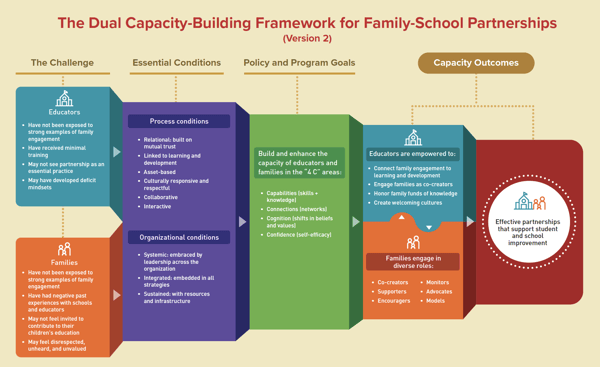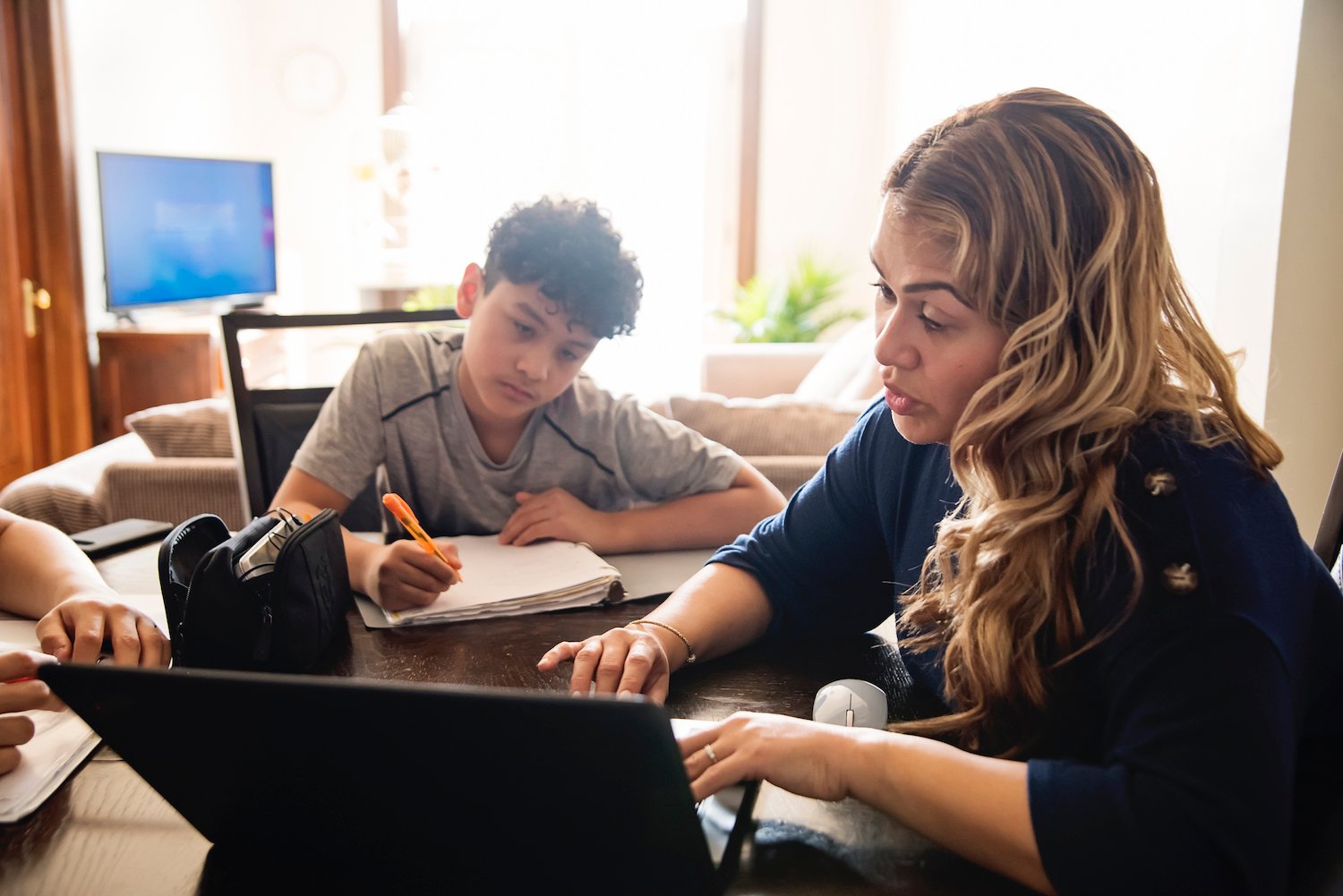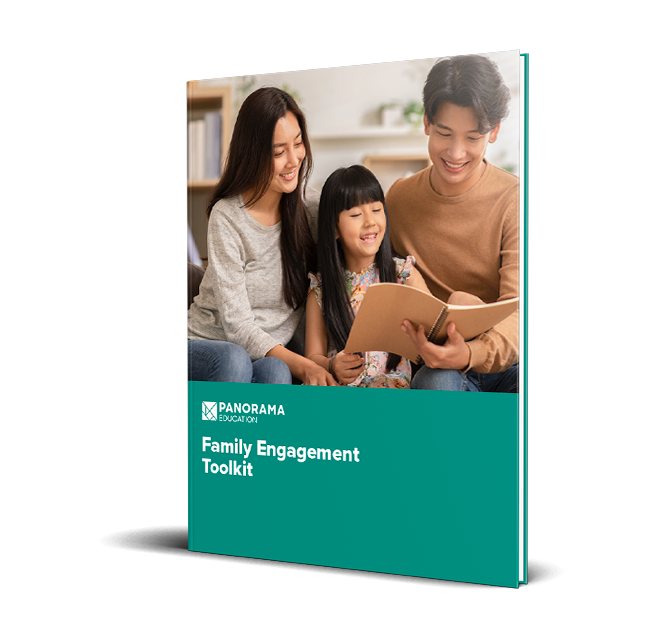Parents are the experts on their children. Yet, district leaders know that promoting family engagement is far from a simple endeavor.
Educators and administrators play a large role in shaping family-school partnerships. When schools elevate families as true partners and the experts that they are, students benefit significantly. When districts support families through thoughtful policies and programs, it encourages broader community engagement that can help to enrich student learning and optimize student success.
Decades of research outline a clear need for parent involvement in a child's educational experience. When families are engaged in school, their children are more likely to succeed.
However, the research also shows that there are many common barriers to parental involvement. These barriers—such as a lack of time, childcare needs, and negative perceptions about school and staff—can make it difficult for families to engage in their children's education.
There is no one-size-fits-all approach to family engagement. However, it’s crucial to ensure families have a voice in their child’s educational experience. Random acts of engagement are not enough; districts must look to systematically involve families across all grade levels.
This guide will equip you with the strategies and tools you need to meaningfully and continuously engage families in their children’s learning and development. By the end, you’ll understand common barriers to engaging families, technology-supported strategies for connecting with caregivers, and methods for enabling family engagement with survey data

Download Resources to Support Family Engagement
Use the guides and strategies in this toolkit to develop meaningful family engagement initiatives.
What is Family Engagement?
Family engagement is the shared responsibility of family members, schools, and communities. District and school leaders often consider family engagement a two-way process that begins in early childhood education, persists through high school, and occurs across multiple settings where children learn.
Relational trust, mutual respect, and cultural responsiveness are pillars of systemic family engagement. The Global Family Research Project, led by researchers at Harvard University, identifies systemic family engagement – that is, parent engagement that is integrated into school structures and educator professional development – as a core component of educational goals, such as student achievement, school turnaround, and school readiness.
Family engagement requires a commitment from school leaders and educators to:
- Create and sustain partnerships that are ongoing, mutual, built on trust and respect
- Focus on supporting family well-being and student achievement
- Honor and support the strengthening of parent-child relationships, which are central to a child’s healthy development, school readiness, and well-being.
To recognize the many different types of family configurations, researchers and youth-serving organizations tend to include parents as well as other adult caregivers in the definition of "family." For instance: many early childhood education centers describe family engagement as including biological, adoptive, and foster parents; grandparents; legal guardians and informal guardians; and adult siblings.
Questions to Consider
|
Why is Family Engagement Important?
Research shows that involving families in their children’s education is paramount to student success. When families are meaningfully and continuously engaged in their children's learning and development, it has a positive impact on their child's health, academic, and well-being outcomes. Furthermore, numerous studies have shown that family involvement can benefit all students, especially those less likely to succeed in school.
- Improved Student Achievement: Cumulative evidence from decades of research indicates that strong relationships among schools, families, and community members can positively impact student achievement and well-being.
- Equal Learning Opportunities: Family involvement has been shown to benefit children from diverse ethnic and socioeconomic backgrounds. For instance: Latino youth with parents who provide encouragement and emphasize the value of education as a way out of poverty tend to have higher grades.
- Higher Grades: Schools that engage families find that their students have higher grades, show faster rates of literacy acquisition, attend school more regularly, and are more likely to graduate from high school and attend college.
- Improved Work Habits: Children in grades K-3 whose parents participate in school activities tend to develop high-quality work habits and task orientation compared to children whose parents did not participate.
- Stronger District/Family Relationships: At a more holistic level, many studies support the importance of partnerships among families, schools, and the broader community.
- Less Delinquency: Adolescents whose parents monitor their academic and social activities have lower rates of delinquency and higher rates of social competence and academic growth.
- Enhanced Student Achievement: Emerging research suggests that teachers, parents, and administrators can play an instrumental role in facilitating successful partnerships and improving relationships to enhance student achievement.
- Better Trust: Research shows that a lack of trust is often what keeps historically marginalized families (which includes families of language learners) from spending time at school.
Questions to Consider:
|
Identifying Barriers to Family Engagement
We know that engaging families is critical for student success—in academics and life skills— as well as for the overall school climate.
Now, let’s discuss the barriers that can prevent families from effectively engaging with school. Many of these barriers – such as families perceiving school staff as too busy to interact with them or that the school doesn’t properly communicate opportunities to be involved – are areas that administrators and teachers can improve when they understand the underlying obstacle or challenge.
Common Barriers to Family Engagement
The following factors are commonly cited in research as barriers preventing families from engaging in their child's educational experience:
- Busy work schedule for parents
- Childcare needs
- Staff and school seem too busy
- Fears that adults at school will treat their children differently if they raise a concern
- Lack of trust
- Lack of information about involvement opportunities
- Lack of guidance on how to communicate with the school
- Transportation-related challenges
- Low feelings of belonging with the school community
How to Measure Family Engagement
In order to better collaborate with families, districts and schools need to better understand the needs, obstacles and challenges facing caregivers. Too often, educator perceptions of family engagement barriers do not align with families' experiences.
Conducting bi-annual, district-wide family surveys is one way to collect robust data that can elevate family voices and experiences.
By conducting a survey of your families, your school or district can hear from a representative group of parents and guardians, rather than relying only on the perspectives of parents who are already highly engaged in advisory committees or PTA groups.
Panorama Education's Family-School Relationships Survey – developed in partnership with Dr. Karen Mapp and researchers at the Harvard Graduate School of Education – provides districts with a clear picture of family attitudes about a wide array of topics, including:
- School Fit: Families' perceptions of how well a school matches their child's developmental needs (e.g., how well do you feel your child’s school is preparing him/her for his/her next academic year?)
- Family Efficacy: How confident families are with regard to key parenting skills (e.g., how confident are you in your ability to support your child’s learning at home?)
- School Climate: Perceptions of the overall social and learning climate of their child's school (e.g., to what extent do you think that children enjoy going to your child’s school?)
- Barriers to Engagement: Factors that can create challenges for families to interact with their child's school. (e.g., how big of a problem are the following issues for becoming involved with your child’s current school?)
In aggregating our dataset of responses of over 18,000 parents and guardians from diverse school communities across the country, several themes emerged in terms of common barriers to engagement for families. The most common barrier to engagement is a lack of time, with 54 percent of parents and guardians reporting that their busy schedule is a “medium” to “very large” problem for becoming involved in their child's school. Other top barriers to engagement include:
- Childcare needs
- A perception that school staff seem too busy
- A belief that school staff will treat their child differently if the parent or guardian raises a concern
- A lack of information provided from the school about involvement opportunities
Questions to Consider:
|
5 Strategy Examples for Supporting Family Engagement in Schools
The work doesn’t stop once your district has identified the barriers or obstacles to family engagement. With survey data readily available, family engagement coordinators and district leaders can take targeted steps to reduce these barriers through targeted strategies that build authentic family-school partnerships.
A strong family engagement plan consists of thoughtful strategies that are grounded in feedback from both caregivers and as educators.
1. Ground your district's strategic planning in an evidence-based family engagement framework
The Dual Capacity-Building Framework for Family-School Partnerships is a valuable resource to consider when developing family engagement strategies.

2. Invite families to share priorities, concerns, and feedback
Using family surveys, administrators can invite caregivers to document their perceptions of their child's experience in school. The data gathered can help districts better understand the experience of all caregivers, delve into potential disparities occurring on demographic and socioeconomic lines, and institute policy and programmatic changes accordingly.
Families can also share any skills or contributions they would like to offer to the school community. School leaders can then provide families with volunteer opportunities to match those skills and interests.
3. Bring families into the decision-making process
Successful family engagement programs are built on a foundation of joint decision-making and goal setting. Inviting families to take part in this work can increase caregiver engagement and reinforce that their involvement will have a direct impact on their children’s education and well-being.
Some districts invite caregivers to be part of their decision-making process through specific councils or committees that are tasked with setting school policies or developing enrichment programs.
Other districts create advisory committees composed of teachers, administrators, parents, and community leaders to solicit and provide input on educational initiatives and policy.
4. Offer flexibility and a variety of options for family involvement
Flexibility is key. Not all parents have time to visit school in the middle of the day or to attend meetings on school nights. Although some parents may want to be involved in projects or committees, they may lack the time, resources, or social capital to engage.
Here are examples of ways to set up flexible pathways for parental involvement.
- Offer supplementary educational resources to support learning at home (both for academics and life skills) via a school newsletter, social media updates, or in-person workshops. Families should receive frequent, digestible information on curriculum, instructional strategies, student assessment data, and overall student progress.
- Set up online and mobile event registration and/or host events for parents online to make it easier for parents to participate. Also consider recording these sessions to share with parents who could not attend live.
- When asking for help with fundraising, event planning, or field trip coordination, always include multiple options for parent participation. For example, provide options for helping during and after school hours. Ask parents to recommend community organizations that the school could collaborate with. Make it clear that any and all help—no matter how small the contribution—is valued.
- Set up a parent-teacher home visit program. Research points to numerous benefits when teachers visit the homes of their students, including increased connection between teachers and parents, more parental engagement in a child's academics, increased trust and communication, and better student behavior.
- Launch a literacy-themed family teacher night, similar to the one that Wake County Public School System piloted (details in this blog post).
When schools offer flexible options for parents to get involved, and parents can start to see the positive benefit of investing in school initiatives, engagement efforts are far more likely to be successful.
5. Leverage a variety of tools to facilitate meaningful, two-way communication
When implemented effectively, parental engagement strategies employ consistent, two-way, meaningful communication to ensure parents are viewed as full partners in their children's education and included (and truly heard) in decision-making processes that involve their school's various education programs.
According to a 2018 report on community engagement, parents want timely and impactful communication from their child's school. They want to be kept informed without feeling overwhelmed.
Two-way communication (correspondence that goes back-and-forth between parents and educators as equals) is crucial to conveying care and building trust. One-way communication (communication that only flows from the school to the home) is inadequate for deeply attending to families' experiences, strengths, and needs. Districts need to allow for both school- and family- initiated communication that is timely and continuous, focuses on a child's educational experience, and reflects each family's language preference.
In the past decade, technology-enabled family engagement has emerged as a new option for schools. When assessing which tools or mediums are a best fit for your district's unique context (and your families' unique needs), consider some of our favorite options:
- Communication Tools: Apart from the main social media platforms, tools such as Remind and ClassDojo make it possible for teachers to virtually bring parents into the classroom. These apps allow teachers and parents to communicate and share information quickly. Both options offer translation capabilities. Another app, Ready4K, offers evidence-based text messages for parents that can deliver an entire family engagement curriculum via SMS.
- Video Tools: In addition to connecting with families via Zoom, educators can share news about student work or create lessons for families to view online using platforms such as Educreations, Flipgrid, or Screencastify. These tools also allow educators to record videos of announcements, record lessons to share with parents, or capture student learning through digital portfolios.
- Virtual Classroom Spaces: Kidblog and Padlet are popular tools that can create a classroom space in the form of a blog or a class website. The goal is to create a centralized location for families to bookmark and refer back to when they have questions or want to see updates from the school. Maintaining a blog or website can help alleviate the barriers of time and lack of information, as families can refer to these spaces when convenient.
Questions to Consider:
|
Strengthening Family Engagement in Your District
Building authentic family-school partnerships doesn’t happen by chance—it happens through intentional listening, consistent communication, and a shared commitment to student success.
Panorama’s Family Engagement Toolkit gives you everything you need to put those ideas into action. Inside, you’ll find:
-
100+ survey questions to elevate family voice and uncover barriers to engagement
-
Guides and strategies to help your district reduce common obstacles to participation
-
Home visit and conference resources that foster trust and connection between families and educators
When families feel seen, heard, and supported, students thrive.
Download the Family Engagement Toolkit to start strengthening partnerships in your district today.







